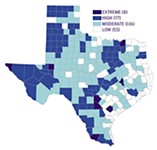Homelessness in San Antonio and Austin
A One-Campus Solution?
By Katherine Gregor, Fri., Aug. 28, 2009

"We, as a community, have a problem. But it's not so severe as the problem of the person sleeping on the street tonight." That reminder from moderator John Nyfeler kicked off a passionate Aug. 12 conversation among those who work with or are touched by the "homeless problem" in Austin. Several dozen met at City Hall to debate the pros and cons of following San Antonio's example: creating a new, one-stop campus that offers comprehensive services and transition assistance to the homeless.
Most in attendance, at the invitation of City Council Member Sheryl Cole, had traveled in July to Haven for Hope, a $90 million, 37-acre campus under construction about two miles from downtown San Antonio. Participants included about 50 city of Austin and Travis County elected officials, social service agency providers, criminal justice officials, and community leaders. The broad attendance on the full-day tour, co-organized by the Downtown Austin Alliance and County Court 5 Judge Nancy Hohengarten, testified to the diverse, systemic stresses that homelessness creates on local nonprofits, churches, hospitals, mental health agencies, the courts and jails, the urban core, and the larger community.
"With numerous services and state-of-the-art facilities situated on the campus, Haven for Hope is designed to provide services that extend far beyond just feeding, clothing, and sheltering the homeless," Cole said. Challenging the group to consider a similar campus approach for Austin, Cole called for people to get "serious about doing something, not just talking about it." But nonprofit staff already providing homeless services were wary of embracing the single-campus approach. For starters, Haven for Hope won't open until later this year, so its effectiveness remains unknown.
San Antonio decided on a "one-stop" approach after researching homelessness issues and visiting facilities in other cities. According to Haven's website (www.havenforhope.org), the one-stop concept of locating "all of the services that they need in one place will make the services more efficient and effective, and will truly help the homeless transform their lives." In 2006, San Antonio's Community Council to End Homelessness found that the most compelling campuses (in San Diego, Miami, Phoenix, and St. Louis) were treating "the root causes of homelessness with a wide array of social services in a single and central location" and reportedly achieving a 60% success rate (defined as a year of self-sufficient living). San Antonio ultimately persuaded the many area organizations already on the job to bring their support and services to a single location.
In addition to food, clothing, and shelter, Haven clients will be able to access a whole village of services, including medical care (dental, mental health, physical/sexual abuse counseling, detox and substance abuse assistance), a pet shelter, child care, a barber shop, legal aid, a chapel, a community court, computers, and phones. Job training, GED education, and job leads will help clients move toward self-sufficiency. The independent nonprofit, composed predominantly of faith-based agencies, hopes to move people out of homelessness permanently.
Yet the Austin group mostly expressed caution about a Haven-type campus as a comprehensive Austin solution. "We've done a pretty damn good job of trying to co-locate services in the Downtown area," said one Front Steps staffer. One unaddressed issue is exactly where such a large local campus – with "lots of breathing space" – might be sited. Widespread "not in my backyard" opposition resulted in the decision to build the Austin Resource Center for the Homeless facility Downtown; while a campus approach was considered then, said those involved, sufficient acreage wasn't available in any NIMBY-free zone.
In the end, Cole pushed participants again to take action, asking all to "continue the conversation to determine the next steps to be done." Those steps could include a careful review of what's working and available now and a gap analysis of key missing elements. In the end, several participants expressed excitement about the Haven for Hope model, and simply about all the right players coming together: "We have some political strength!"
Got something to say on the subject? Send a letter to the editor.









